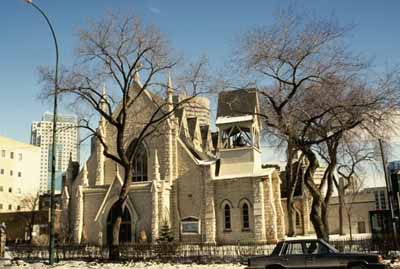Holy Trinity Anglican Church National Historic Site of Canada
Winnipeg, Manitoba

General view
© Parks Canada Agency / Agence Parcs Canada, 1994.
Address :
269 Donald Street (at Graham Avenue), Winnipeg, Manitoba
Recognition Statute:
Historic Sites and Monuments Act (R.S.C., 1985, c. H-4)
Designation Date:
1990-02-23
Dates:
-
1883 to 1884
(Construction)
Event, Person, Organization:
-
Parish of Holy Trinity
(Organization)
-
Charles H. Wheeler
(Architect)
Other Name(s):
-
Holy Trinity Anglican Church
(Designation Name)
-
Holy Trinity Church
(Other Name)
Research Report Number:
1989-SUC JUN
Plaque(s)
Existing plaque: on a pedestal on the front lawn 269 Donald Street (at Graham Avenue), Winnipeg, Manitoba
Erected in 1883-1884 to the designs of Winnipeg architect Charles H. Wheeler, this picturesque limestone structure is a fine example of the High Victorian Gothic style. It displays a creative interpretation of the cruciform plan and a lively use of motifs such as dormer clerestory windows, buttresses, finials and hammer beam ceiling. The irregular outline, with attached parish hall and bell tower, recalls English parish churches. This church is the fourth to serve the parish since its incorporation in 1868. Set within a landscaped churchyard, Holy Trinity is a landmark in the heart of Winnipeg.
Description of Historic Place
Surrounded by the large glass and steel buildings of downtown Winnipeg, Holy Trinity Anglican Church National Historic Site of Canada has witnessed the evolution of the district from open prairie to commercial core since its construction in 1883-1884. Recalling parish churches in England, this picturesque rough-cut limestone church is a fine example of High Victorian Gothic style, with the lively interplay of form and detail of finials, buttresses, gables and rooflines. The building has retained an astonishing amount of its original elements, although the main entrance on Donald Street has been sealed and access to the church is now routed through the parish hall. Set within a compact landscaped churchyard, Holy Trinity Church continues to be a vibrant parish within the Anglican Diocese of Rupertsland.
Heritage Value
Holy Trinity Anglican Church was designated as a national historic site in 1990 because: it is a fine example of the High Victorian Gothic style.
When the parish of Holy Trinity outgrew its second church after its formation as a parish in 1867, the congregation awarded the $300 design competition prize to a British-born architect Charles H. Wheeler. An active member of the congregation himself, Wheeler’s design delighted the small ambitious city, but the parish was ultimately obliged to forgo permanently a grand bell tower and spire planned for the southwest corner, due to a lack of funds. Completed in 1884, this church features a cruciform plan in an irregular outline with dormered clerestory windows along the steeply pitched gable roof. The rough-cut honey coloured limestone of the walls is further employed to great advantage in labels over the many pointed windows, and in the dripstones, which end in human faces over the entrances. Twinned buttresses carry the roofline down, each capped with a fanciful turret. A variety of stone crosses over the many gable and dormer peaks speak to the evolution and cultural breadth of this Christian symbol.
The interior features an elaborate hammer beam ceiling and magnificent stained glass windows. Within its pointed arches, the elaborate Gothic tracery of the chancel and entrance windows is reduced to a simpler form in the windows along the nave. Above, each clerestory window exhibits the trefoil tracery appropriately symbolizing the Holy Trinity. Finished in a dark stained wood, the hammer beam ceiling continues the window tracery in a larger scale that weaves up in an elaborate manner, the arches carried down on to painted pillars capped with a display of cast human and animal heads, scrolls and leaves. With most of its original layout and furnishings intact, the church interior has a remarkable integrity, which has been supported by a long-term regime of maintenance and care.
A 1912 church hall that blocked the stained glass window at the rear of the chancel was replaced in 1966 with a lower structure, which was more sensitive to the design of the church, while still providing much-needed space for the parish’s many activities.
Source: Historic Sites and Monuments Board of Canada, Minutes, February 1990.
Character-Defining Elements
Key elements that contribute to the heritage value of the site include: its setting within a compact landscaped churchyard in the heart of downtown Winnipeg; the elements which demonstrate the features of a church in the High Victorian Gothic style; its simple, rectangular massing , and irregular roof line, punctuated by finials and gables; its main façade with projecting entry porch and attached side tower capped by a gable roof; the cruciform plan, the pointed arches of its openings, the irregular outline and the lively use of Gothic decorative motifs; the exterior rough-cut honey coloured Tyndall limestone walls, with buttresses and finials; the exceptional interior woodwork in the hammer beam vaults, carved pews and original liturgical furnishings such as the pulpit and the brass lectern stand, the chancel with segmented arched ceiling in wood, and the chancel’s woodwork screen, and carved figures of human and animal heads and faces, scrolls and leaves; remaining original interior layout and furnishings; the mosaic-tiled floor; the stained-glass windows, their trefoil tracery and the use of dormer windows instead of a clerestory to light the upper part of the interior.